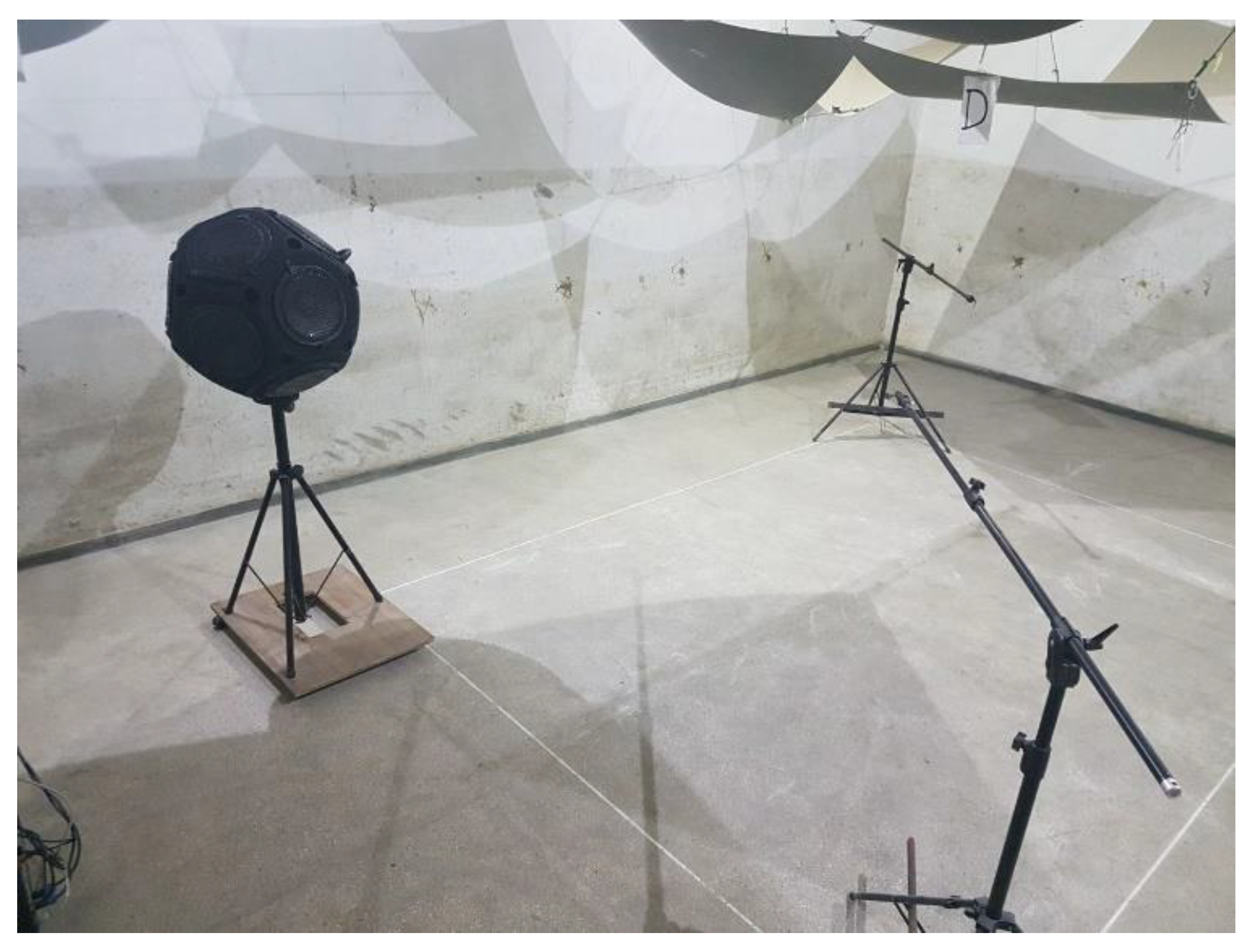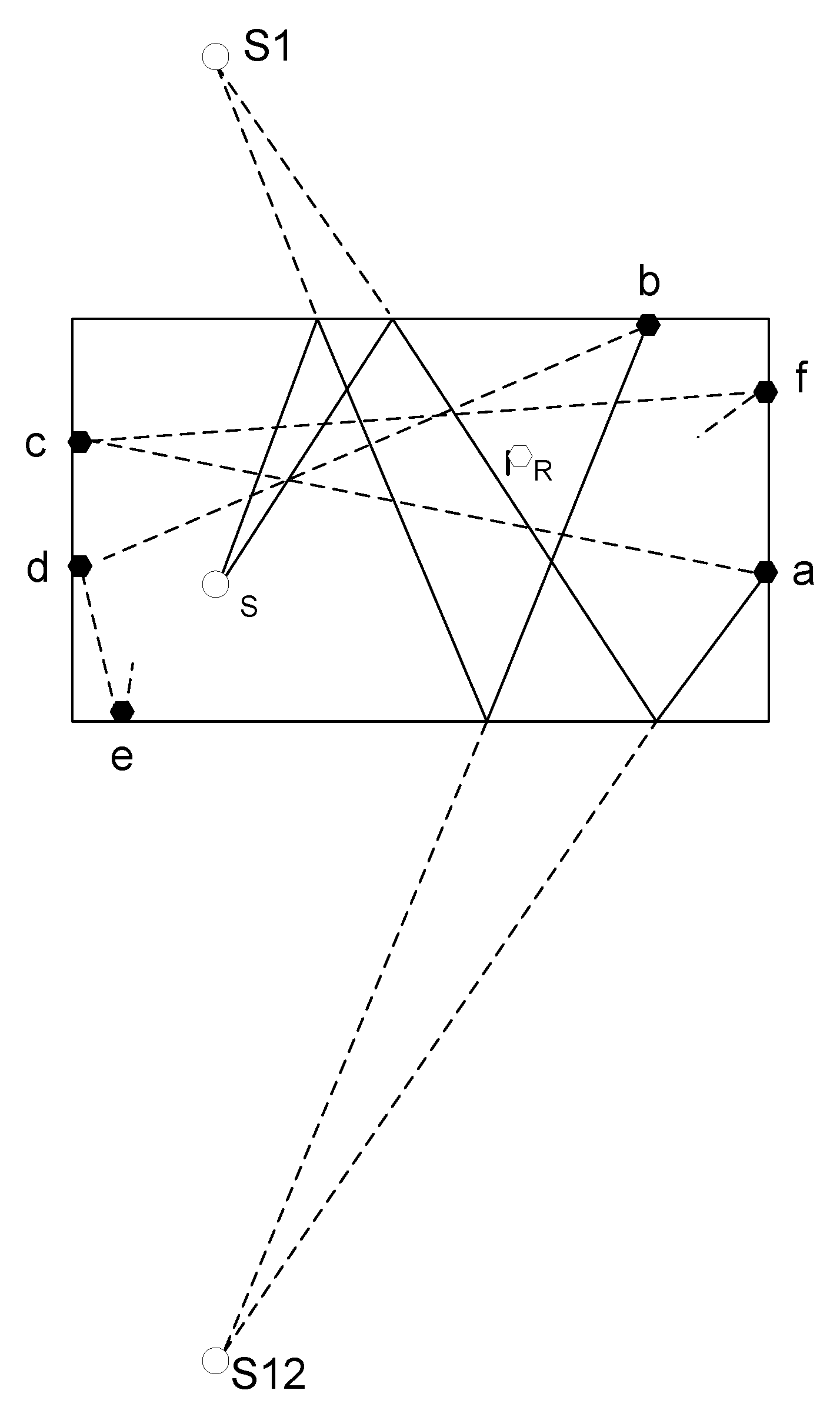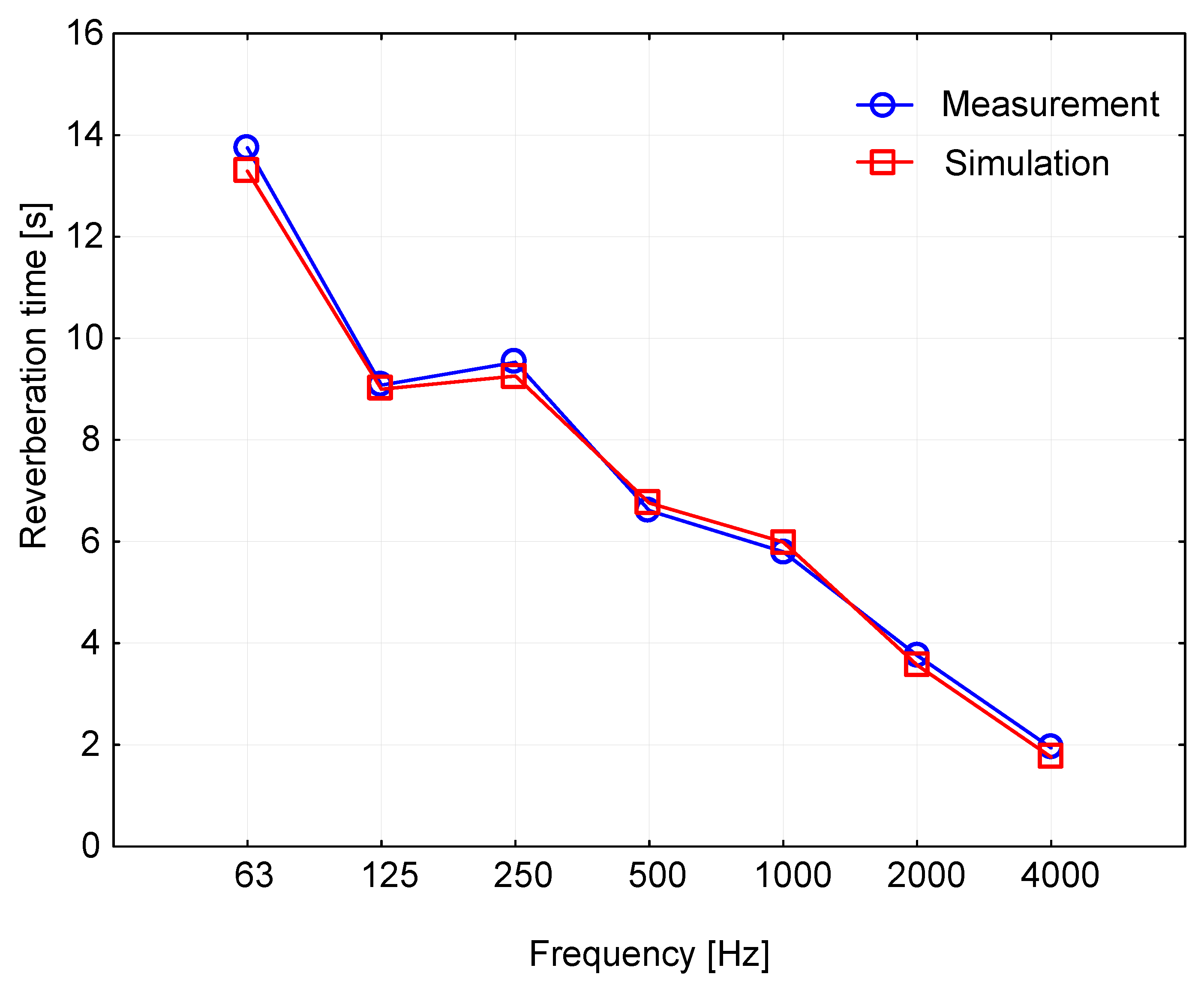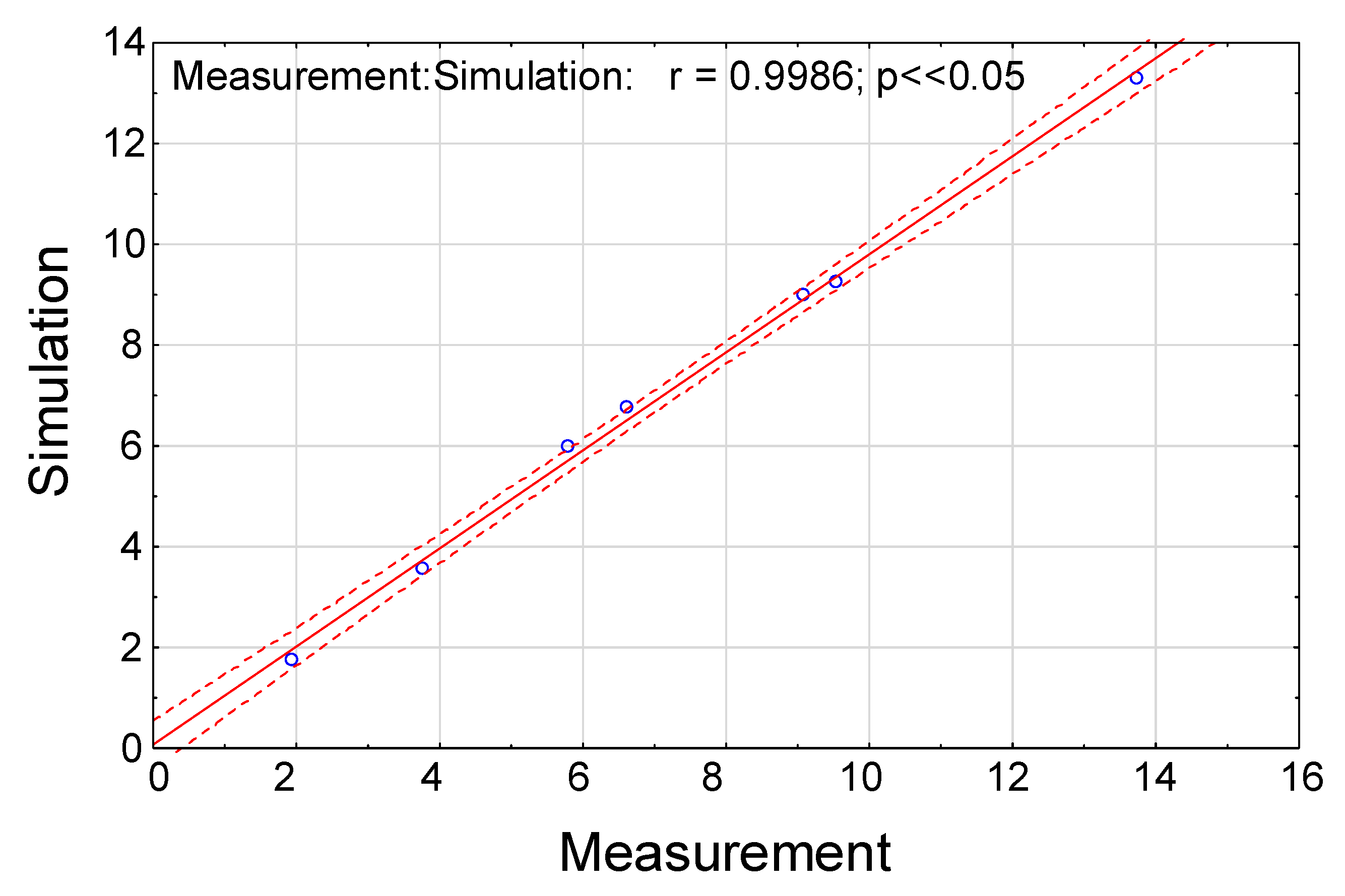Experimental Validation of the Model of Reverberation Time Prediction in a Room
Abstract
1. Introduction
2. Method
2.1. Measurement of Reverberation Time in a Reverberation Room
- lmax—the length of the longest straight line which fits within the boundary of the room (e.g., in a rectangular room it is the major diagonal), in meters,
- V—the volume of the room, in cubic meters.
2.2. Modeling
2.2.1. Ray Method
2.2.2. The Image Source Method
- n—the number of surfaces delimiting the room,
- i—order of reflections of the sound wave.
2.2.3. Hybrid Methods
2.2.4. Computer Simulation Using ODEON
2.2.5. Validation
- E—value of comparison error,
- UV—validation uncertainty.
- δE—experimental error,
- δS—simulation error.
- δSMA—error resulting from the assumption of the model,
- δSPD—error resulting from the use of input data.
- δSN—error resulting from numerical simulation.
- S—simulation result,
- M—measurement result.
- UE—experimental uncertainty,
- USPE—experimental uncertainty in the use of input data,
- US—simulation uncertainty.
3. Results and Discussion
- n—number of measurement samples,
- Ti—i-th measurement of reverberation time,
- —arithmetic mean of all reverberation time measurements.
- k(n)—extension value taking into account the student’s t distribution,
- —arithmetic mean of all reverberation time measurements.
- S—simulation result,
- M—measurement result.
4. Conclusions
- the condition of the correct validation of Equation (5) known from the validation of proprietary numerical models works well during the modeling in ready-made software platforms when the input parameters are subject to high uncertainty;
- the simulation error proposed by the authors with Formula (8) can be successfully used to validate numerical models in ready-made computer programs, when the input parameters are subject to high uncertainty;
- the confirmation of the measurement reflected through simulation may be undertaken through regression analysis, where the regression equation y = x is interpreted as a very good (functional) representation.
Author Contributions
Funding
Institutional Review Board Statement
Informed Consent Statement
Data Availability Statement
Conflicts of Interest
References
- Prędka, E.; Brański, A. Analysis of the room Acoustic with impedance boundary conditions in the full range of acoustic frequencies. Arch. Acoust. 2020, 45, 85–92. [Google Scholar]
- Nowoświat, A.; Olechowska, M.; Ślusarek, J. Prediction of reverberation time using the residual minimization method. Appl. Acoust. 2016, 106, 42–50. [Google Scholar] [CrossRef]
- Pilch, A.; Kamisiński, T. The effect of geometrical and material modification of sound diffusers on their acoustic parameters. Arch. Acoust. 2011, 36, 955–966. [Google Scholar] [CrossRef]
- Cerdá, S.; Gimènez, A.; Romero, J.; Cibrián, R.; Miralles, J.L. Room acoustical parameters: A factor analysis approach. Appl. Acoust. 2009, 70, 97–109. [Google Scholar] [CrossRef]
- Visentin, C.; Prodi, N.; Valau, V.; Picaut, J. A numerical and experimental validation of the room acoustics diffusion theory inside long rooms. In Proceedings of the 21st International Congress on Acoustics, Montreal, QC, Canada, 2–7 June 2013. [Google Scholar]
- Escobar, V.G.; Morillas, J.M. Analysis of intelligibility and reverberation time recommendations in educational rooms. Appl. Acoust. 2015, 96, 1–10. [Google Scholar] [CrossRef]
- Galbrun, L.; Kitapci, K. Accuracy of speech transmission index predictions based on the reverberation time and signal-to-noise ration. Appl. Acoust. 2014, 81, 1–14. [Google Scholar] [CrossRef]
- Meissner, M. Acoustics of small rectangular rooms. Analytical and numerical determination of reverberation parameters. Appl. Acoust. 2017, 120, 111–119. [Google Scholar] [CrossRef]
- Pilch, A. Optimization-based method for the calibration of geometrical acoustic models. Appl. Acoust. 2020, 170, 107495. [Google Scholar] [CrossRef]
- Magoules, F. (Ed.) Computional Methods for Acoustics Problems; Saxe-Coburg Publications: Stirling, UK, 2009. [Google Scholar]
- Atalla, N.; Sgard, F. Finite Element and Boundary Methods in Structural Acoustics and Vibration; CRC Press: Boca Raton, FL, USA, 2015. [Google Scholar]
- Bilbao, S.; Ahrens, J.; Hamilton, B. Incorporating sources directivity in wave-based virtual acoustics: Time-domain models and fitting to measured data. J. Acoust. Soc. Am. 2019, 146, 2692–2703. [Google Scholar] [CrossRef]
- Sakuma, T.; Sakamoto, S.; Otsuru, T. Computional Simulation in Architectural and Environmental Acoustics; Springer: Tokyo, Japan, 2014. [Google Scholar]
- Hargreaves, J.A.; Rendell, L.R.; Lam, Y.W. A framework for auralization of boundary element method simulations including source and receiver directivity. J. Acoust. Soc. Am. 2019, 145, 2625–2637. [Google Scholar] [CrossRef]
- Thydal, T.; Pind, F.; Jeong, C.H.; Emgsig-Karup, A.P. Experimental validation and uncertainty quantification in wave-based computational room acoustics. Appl. Acoust. 2021, 178, 107939. [Google Scholar] [CrossRef]
- Li, Y.; Meyer, J.; Lokki, T.; Cuenca, J.; Atak, O.; Desmet, W. Benchmarking of finite-difference time-domain method and fast multipole boundary element method for room acoustics. Appl. Acoust. 2022, 191, 108662. [Google Scholar] [CrossRef]
- Kirkup, S. The boundary element method in acoustics: A survey. Appl. Sci. 2019, 9, 1642. [Google Scholar] [CrossRef]
- Gumerov, N.A.; Duraiswami, R. Fast multipole accelerated boundary element methods for room acoustics. J. Acoust. Soc. Am. 2021, 150, 1707–1720. [Google Scholar] [CrossRef] [PubMed]
- Pelzer, S.; Aspöck, L.; Schröder, D.; Vorlönder, M. Integrating real-time room acoustics simulation into a CAD modeling software to enhance the architectural design process. Buildings 2014, 4, 113–138. [Google Scholar] [CrossRef]
- Savioja, L.; Svensson, U.P. Overwiew of geometrical room acoustic modeling techniques. J. Acoust. Soc. Am. 2015, 138, 708–730. [Google Scholar] [CrossRef]
- Winkler-Skalna, A.; Nowoświat, A. Use n-perturbation interval ray tracing method in predicting acoustic field distribution. Appl. Math. Model. 2021, 93, 426–442. [Google Scholar] [CrossRef]
- Panahi, E.; Younesian, D. Acoustic performance enhancement in a railway passenger carriage using hybrid ray-tracing and image-source method. Appl. Acoust. 2020, 170, 107527. [Google Scholar] [CrossRef]
- D’Antonio, P.; Cox, T.J. Diffusor application in rooms. Appl. Acoust. 2000, 60, 113–142. [Google Scholar] [CrossRef]
- Cox, T.J.; D’Antonio, P.; Vorlaender, M. A tutorial on scattering and diffusion coefficients for room acoustic surfaces. Acta Acoust. Acust. 2006, 92, 1–15. [Google Scholar]
- Tenenbaum, R.A.; Camilo, T.S.; Torres, J.C.B.; Gerges, S.N.Y. Hybrid method for numerical simulation of room acoustics: Part 1-theoretical and numerical aspects. J. Braz. Soc. Mech. Sci. Eng. 2007, 29, 211–221. [Google Scholar] [CrossRef][Green Version]
- Stephenson, U. Analytical derivation of a formula for the reduction of computation time by the voxel crossing technique used in room acoustical simulation. Appl. Acoust. 2006, 67, 959–981. [Google Scholar] [CrossRef]
- Noriega-Linares, J.E.; Navarr, J.M. On the relations of room acoustic diffusion over binaural loudness. In Proceedings of the Euro Regio, Porto, Portugal, 13–15 June 2016. [Google Scholar]
- Vorländer, M. Computer simulations in room acoustics: Concept and uncertainties. J. Acoust. Soc. Am. 2013, 133, 1203–1213. [Google Scholar] [CrossRef] [PubMed]
- Berndäo, E.; Santos, E.S.O.; Melo, V.S.G.; Tenenbaum, R.A.; Meareze, P.H. On the performance investigation of distinct algorithms for room acoustics simulation. Appl. Acoust. 2022, 187, 108484. [Google Scholar] [CrossRef]
- Passero, C.R.M.; Zannin, P.H.T. Statistical comparison of reverberation times measured by the integrated impulse response and interrupted noise method, computionally simulated with ODEON software, and calculated by Sabine, Eyring and Arau-Puchades’ formulas. Appl. Acoust. 2010, 71, 1204–1210. [Google Scholar] [CrossRef]
- Nowoświat, A.; Olechowska, M.; Marchacz, M. The effect of acoustical remedies changing the reverberation time for different frequencies in a dome used for worship: A case study. Appl. Acoust. 2020, 160, 107143. [Google Scholar] [CrossRef]
- Nowoświat, A.; Bochen, J.; Dulak, L.; Żuchowski, R. Study on sound absotption of road acoustic screens under simulated weathering. Arch. Acoust. 2018, 43, 323–337. [Google Scholar]
- ISO 354: 2003; Acoustics—Measurement of Sound Absorption in a Reverberation Room. ISO: Geneva, Switzerland, 2003.
- Nowoświat, A.; Bochen, J.; Dulak, L.; Żuchowski, R. Investigation studies involving sound absorbing parameters of roadside screen panels subjected to aging in simulated conditions. Appl. Acoust. 2016, 111, 8–15. [Google Scholar] [CrossRef]
- Hohenwarter, D.; Jelinek, F. Snell’s law of refrectaction and sound rays for a moving medium. J. Acoust. Soc. Am. 1999, 105, 1387. [Google Scholar] [CrossRef]
- Zeng, X.; Christensen, C.L.; Rindel, J.H. Practical methods to define scattering coefficients in a room acoustics computer model. Appl. Acoust. 2006, 67, 771–786. [Google Scholar] [CrossRef]
- Vian, J.P.; van Maercke, D. Calculation of the room impulse response using a Ray-Tracking Method. In Proceedings of the ICA Symposium on Acoustics and Theatre Planning for the Performing Arts, Vancouver, BC, Canada, 4–6 August 1986. [Google Scholar]
- Vorländer, M. Simulation of the transient and steady-state sound propagation in rooms using a new combined ray-tracing/image source algorithm. J. Acoust. Soc. Am. 1989, 86, 172–178. [Google Scholar] [CrossRef]
- Rindel, J.H. The use of computer modeling in room acoustics. J. Vibroeng. 2000, 3, 219–224. [Google Scholar]
- Gkanos, K.; Pind, F.; Sørensen, H.H.B.; Jeong, C.H. Comparison of aparallel implementation strategies for the image source method for real-time virtual acoustics. Appl. Acoust. 2021, 178, 108000. [Google Scholar] [CrossRef]
- Naylor, G.M. ODEON—Another hybrid room acoustical model. Appl. Acoust. 1993, 38, 131–143. [Google Scholar] [CrossRef]
- Stern, F.; Wilson, R.; Coleman, H.; Paterson, E.G. Comprehensive approach to verification and validation of CFD simulations—Part 1: Methodology and procedures. J. Fluids Eng. 2001, 123, 793–802. [Google Scholar] [CrossRef]
- Stern, F.; Wilson, R.; Shao, J. Quantitative V&V of CFD simulations and certification of CFD codes. Int. J. Numer. Methods Fluids 2006, 50, 1335–1355. [Google Scholar]






| Frequency [Hz] | Adopted Sound Absorption Coefficients | Sound Absorption Coefficients of Concrete |
|---|---|---|
| 63 | 0.011 | 0.01 |
| 125 | 0.016 | 0.01 |
| 250 | 0.015 | 0.02 |
| 500 | 0.02 | 0.02 |
| 1000 | 0.02 | 0.02 |
| 2000 | 0.026 | 0.02 |
| 4000 | 0.03 | 0.05 |
| Frequency [Hz] | Measurement [s] | Simulation | Validation Error (8) |
|---|---|---|---|
| 63 | 13.75 | 13.29 | 0.46 |
| 125 | 9.08 | 9.00 | 0.08 |
| 250 | 9.53 | 9.26 | 0.27 |
| 500 | 6.61 | 6.76 | 0.15 |
| 1000 | 5.8 | 5.99 | 0.19 |
| 2000 | 3.76 | 3.57 | 0.19 |
| 4000 | 1.94 | 1.76 | 0.18 |
| average 500, 1000, 2000 | 5.39 | 5.44 | 0.05 |
| Frequency [Hz] | Parameters of Error [%] | Value of Error [%] | |
|---|---|---|---|
| δE | δS | ||
| 63 | 5.74 | 3.34 | 2.4 |
| 125 | 3.01 | 0.88 | 2.13 |
| 250 | 1.92 | 2.83 | 0.91 |
| 500 | 1.38 | 2.27 | 0.89 |
| 1000 | 0.98 | 3.28 | 2.3 |
| 2000 | 0.64 | 5.05 | 4.41 |
| 4000 | 0.59 | 9.28 | 8.69 |
| Frequency [Hz] | Uncertainty of Measurement and Simulation [%] | Uncertainty [%] | |
|---|---|---|---|
| UE | US | UV | |
| 63 | 11.26 | 3.34 | 11.74 |
| 125 | 5.90 | 0.88 | 5.96 |
| 250 | 3.76 | 2.83 | 4.71 |
| 500 | 2.70 | 2.27 | 3.53 |
| 1000 | 1.92 | 3.28 | 3.80 |
| 2000 | 1.25 | 5.05 | 5.20 |
| 4000 | 1.15 | 9.28 | 9.35 |
Publisher’s Note: MDPI stays neutral with regard to jurisdictional claims in published maps and institutional affiliations. |
© 2022 by the authors. Licensee MDPI, Basel, Switzerland. This article is an open access article distributed under the terms and conditions of the Creative Commons Attribution (CC BY) license (https://creativecommons.org/licenses/by/4.0/).
Share and Cite
Nowoświat, A.; Olechowska, M. Experimental Validation of the Model of Reverberation Time Prediction in a Room. Buildings 2022, 12, 347. https://doi.org/10.3390/buildings12030347
Nowoświat A, Olechowska M. Experimental Validation of the Model of Reverberation Time Prediction in a Room. Buildings. 2022; 12(3):347. https://doi.org/10.3390/buildings12030347
Chicago/Turabian StyleNowoświat, Artur, and Marcelina Olechowska. 2022. "Experimental Validation of the Model of Reverberation Time Prediction in a Room" Buildings 12, no. 3: 347. https://doi.org/10.3390/buildings12030347
APA StyleNowoświat, A., & Olechowska, M. (2022). Experimental Validation of the Model of Reverberation Time Prediction in a Room. Buildings, 12(3), 347. https://doi.org/10.3390/buildings12030347






